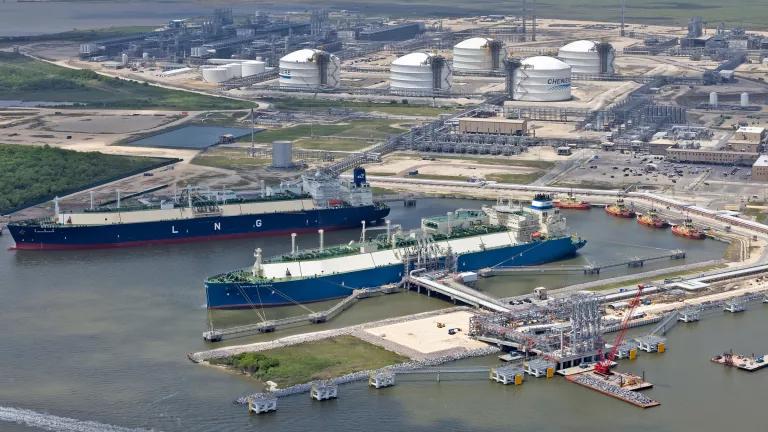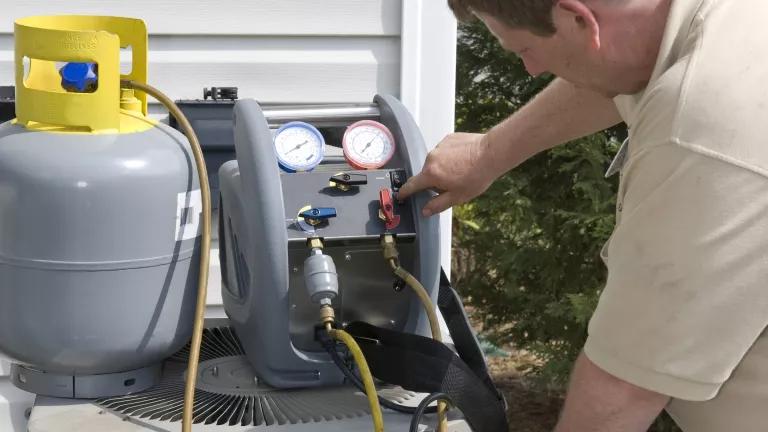How the Biomass Industry Sent “Sustainability” Up in Smoke

Countries around the world are seeking alternatives to fossil fuels. Energy efficiency, genuine zero-emission renewable energy sources like solar and wind, and smart resources like batteries that can store electricity until it’s needed are cheaper than ever and deploying fast. But one technology gets grouped with other renewables but doesn’t belong: biomass.
Biomass refers to burning plant matter for energy. It’s particularly harmful to the environment when biomass from forests—aka trees—is burned for electricity. Harvesting wood for energy production worsens climate change immediately, and the harms it causes can persist for many decades or even centuries. It also endangers the very ecosystems we rely on to help stabilize global temperature rise and make communities more resilient to climate change. Biomass proponents argue that so long as trees are sourced “sustainably,” policymakers can ignore these impacts. The reality is that their sustainability claims simply greenwash climate pollution and forest destruction.
The biomass industry typically uses one of three tricks to pull the “sustainability” veil over its climate and forest impacts—or all three at once! First, the industry emphasizes that it only sources wood from “working forests,” “managed forests,” or forests with “sustained yield” management practices. Second, it touts that its biomass has been certified under some sustainable forestry scheme, such as the Sustainable Biomass Program. Third, it assures policymakers that the wood it burns is just “waste” or “low grade wood” or otherwise “unmerchantable.”
Let’s take these one by one.
1. If biomass harvest does not exceed forest growth, biomass can be treated as carbon neutral.
The biomass industry often defines “sustainability” as sourcing wood from “working forests,” “managed forests,” or forests with “sustained yield” management practices. These industry terms feature a common assumption: that if biomass harvest does not exceed forest growth in a given sourcing area, policies can treat the biomass as a “zero-carbon” or carbon beneficial fuel at the point of combustion—in essence, on par with solar and wind. This assumption is erroneous and has been soundly debunked by scientists.
Sustainable forestry may be based on ecological and other management considerations, but carbon accounting is not one of them. Even when forest growth and removals are considered (i.e., “sustained yield”), sustainability criteria fail to fully account for net changes in carbon emissions from forest biomass—i.e. what would have happened to forest carbon in the absence of harvesting biomass had the forest been allowed to continue growing—and cannot be justified scientifically as a proxy for carbon accounting.
Here’s what the science actually says:
Per unit of energy, all existing biomass power plants emit more CO2 from their smokestacks than coal plants. Thus, the inevitable initial impact of replacing coal with forest biomass in power stations is to increase CO2 levels in the atmosphere. On the landscape, replacing older trees with saplings reduces the amount of carbon stored in the forest, even under the best-case scenario in which trees are replanted immediately and kept intact. Taken together, this means it can take anywhere from decades to over a century for biomass energy systems to begin to deliver any climate benefits whatsoever.
The worst impacts on the climate come when biomass-fueled power plants burn whole trees. But even when biomass energy is generated by burning genuine forestry residues, the result is still more climate pollution for decades. Thus, any climate benefits that come with burning forest biomass are a) highly theoretical; and b) come far outside critical timeframes for dramatically cutting emissions and averting climate disaster.
2. We’re “green.” Just look at our sustainability certification!
Years of on-the-ground investigations have shined a spotlight on the realities of biomass supply chains, including sourcing biomass from clearcuts of mature hardwood forests, to the vast quantities of whole trees getting ground up into pellets to be shipped around the world and burned in power plants. It’s hard to look at the images from these investigations and conclude that burning forest biomass for energy is in any way good for the environment. So the biomass industry went out and got themselves a sustainable certification scheme to provide some “green” cover.
The Sustainable Biomass Program (SBP), used by wood pellet manufacturing giants like Enviva and their top customers, such as Drax Power in the UK, to certify their biomass, was created in 2013 by biomass companies to provide assurances that their wood pellets and other biomass fuel are sustainable and legally sourced. Unfortunately, from the start, this certification scheme was dominated by industry and built using a self-policing approach that has resulted in increased carbon emissions, accelerated loss of natural forests, and harm to local communities. It amounts to little more than a smokescreen for forest destruction, as detailed in our report about its deep flaws and deficiencies.
But it’s not just that the SBP is like leaving the fox to guard the henhouse. None of the sustainable forestry certifications programs—even the most rigorous programs, which NRDC supports—include a carbon accounting mechanism. It's simply not what they were created for. As such, “sustainable forestry” or “environmentally sustainable” practices, while plausibly beneficial for timber management or ecosystem/wildlife protection, cannot be treated as providing evidence that biomass harvested for energy production is carbon-beneficial.
3. We only burn the trees that no one else wants.
The final trick deployed by the biomass industry is to assure policymakers that the wood it burns is just “waste wood” or “low grade wood” or otherwise “unmerchantable.” But feedstock categories that have become codified in biomass regulations are carry-overs from an entirely different industry. Forestry industry terms (e.g. “thinnings,” “unmerchantable trees”) may make sense in the context of traditional forest products—lumber, pulp and paper, plywood, and so forth—but these terms were never intended to communicate anything whatsoever about the net carbon emissions associated with different types of woody biomass in the context of energy production or climate policy. What is a “waste,” “residue,” or otherwise “low-value” wood product in traditional forest product markets still emits CO2 when burned as fuel for electricity generation, and it is scientifically indefensible to assume otherwise.
Further, when you decode this industry jargon into regular English, many of the terms are really just code words for trees. Yet, these feedstocks make up the bulk of what biomass power stations are burning. According to its own 2018 annual report, “thinnings” and “low grade roundwood”—aka trees—made up fully half of the biomass imported by Drax, and the majority of the biomass the company imported from the U.S. Southeast (60%).
The bottom line is that if policymakers are looking to “sustainability” claims to provide assurances about the carbon benefits of forest biomass, they are barking up the wrong tree. Burning forest biomass cannot reduce emissions compared with fossil fuels within timeframes relevant to averting the worst dangers of climate change. What can? Investment in genuinely clean and renewable energy and an ambitious global agenda to protect, restore, and expand forests and other natural ecosystems.


